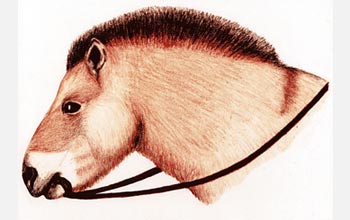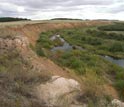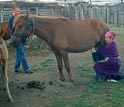News Release 09-038
Evidence of Earliest Known Domestic Horses Found in Kazakhstan
The use of horses for milk and food offers clues to the animals' social significance

Evidence of thong bridle use suggests horses may have been ridden as early as 5,500 years ago.
March 5, 2009
This material is available primarily for archival purposes. Telephone numbers or other contact information may be out of date; please see current contact information at media contacts.
The earliest known domesticated horses were both ridden and milked according to a new report published in the March 6, 2009 edition of the journal Science. The findings by an international team of archaeologists could point to the very beginnings of horse domestication and help explain its early impacts on society.
Researchers from Carnegie Museum of Natural History, Pittsburgh, Pa., and the universities of Exeter and Bristol in the U.K., uncovered the evidence in Kazakhstan, the world's largest landlocked country situated in Central Asia. Data gathered by archaeologists supports the hypothesis that the horse-rich area in the vast, semi-arid, grassy plains, or steppe zones, east of the Ural Mountains in Northern Kazakhstan, contributed largely to the development of two neighboring cultures, the Botai in north-central Kazakhstan and the Tersek in the west.
"Having a domesticated animal that could be eaten, milked, ridden, used as a pack animal and potentially for haulage would have had a tremendous impact on any society that initiated or adopted horse herds," said Sandra Olsen, curator of anthropology at the Carnegie Museum of Natural History.
Olsen directed several archaeological teams that excavated sites in Kazakhstan from 1994-2002. Her work in the Botai Culture sites of Krasnyi Yar in 2000 and Vasilkovka in 2002 was supported by the National Science Foundation. Her earlier work in the region was supported by National Geographic.
Archaeologists say horse domestication may have begun in Kazakhstan about 5,500 years ago, about 1,000 years earlier than originally thought. Their findings also put horse domestication in Kazakhstan about 2,000 years earlier than that known to have existed in Europe.
The research team used various techniques to discover that horses provided food and milk, to show that domestic horses differed from wild horses from the same region, and to prove that horses were harnessed and possibly ridden in the fourth millennium B.C., in Kazakhstan.
Researchers used a novel method of analyzing residue from fat-soluble lipids found on ancient Botai pottery to find traces of fats from horse milk, leading to the conclusion that people consumed horse milk at the beginning of the Copper Age some 5,500 years ago. Mare's milk is still a staple of consumption in Kazakhstan where it's usually fermented into a slightly alcoholic drink called 'koumiss.'
Additionally, examinations of ancient bone remains showed that horses were similar in shape to Bronze Age domestic horses but different from more ancient wild horses from the same region, suggesting that people selected wild horses for their physical attributes, which were exaggerated through breeding.
"It is quite surprising that the Tersek and Botai horse metacarpals differ significantly," said Olsen. "The Tersek culture and the Botai culture are considered to be the same culture by many archaeologists--they are separated by just two days' ride on horseback, and they're very similar in terms of their material culture. To find there may have been a difference in the sizes of their horses was something that I did not expect."
The team also used a technique to search for 'bit damage' caused by bridling or harnessing horses. Researchers found tell-tale traces of the use of a thong bridle on the gap between the teeth of the lower jaw. A thong bridle is simply a leather thong draped over this gap and knotted under the chin, with the trailing ends acting as the reins. Plains Indians called this a war bridle or racing bridle and it most likely is the type of bridle that was developed first.
"The domestication of horses is known to have had immense social and economic significance, advancing communications, transport, food production and warfare," said the Science paper's lead author, Alan Outram of Exeter. He said the findings are significant because they change "our understanding of how these early societies developed."
Some comparisons can be made to the early horse-herder culture of the Plains Indians in America, but with some important differences. First, American Indians did not go through the process of capturing wild horses, taming them, and breeding them to become more well-mannered.
Instead, when the horse was re-introduced to North America by the Europeans--having evolved in North America, spread to Asia and Europe, before going extinct in the New World about 10,000 years ago--it was fully domesticated. "American Indians had the advantage of receiving an animal that was already selected to be more docile and controllable," said Olsen.
"Although the Plains Indians often had to develop their own tack, harnesses and equipment used for riding, they often saw the bridles and other equipment that the Spaniards and other Europeans had.
"There is no question that there are similarities in the Plains Indian societies and some cultures on the Eurasian steppe that depended heavily on the horse, but we must take care in carrying that analogy too far," Olsen said.
Kokshetau University in Kazakhstan also participated in this study and additional funding was provided by the Natural Environment Research Council and British Academy.
-NSF-
-
The grassy plains of Northern Kazakhstan may have been where the first horses were domesticated.
Credit and Larger Version -
Analysis of ancient pottery showed early horse milk consumption, a practice that continues today.
Credit and Larger Version -
The researchers' findings are published in the March 6, 2009, issue of Science magazine.
Credit and Larger Version
Media Contacts
Bobbie Mixon, NSF, (703) 292-8485, email: bmixon@nsf.gov
Program Contacts
John E. Yellen, NSF, (703) 292-8759, email: jyellen@nsf.gov
Principal Investigators
Sandra L. Olsen, Carnegie Museum of Natural History, 412-665-2606, email: olsens@carnegiemnh.org
The U.S. National Science Foundation propels the nation forward by advancing fundamental research in all fields of science and engineering. NSF supports research and people by providing facilities, instruments and funding to support their ingenuity and sustain the U.S. as a global leader in research and innovation. With a fiscal year 2023 budget of $9.5 billion, NSF funds reach all 50 states through grants to nearly 2,000 colleges, universities and institutions. Each year, NSF receives more than 40,000 competitive proposals and makes about 11,000 new awards. Those awards include support for cooperative research with industry, Arctic and Antarctic research and operations, and U.S. participation in international scientific efforts.
Connect with us online
NSF website: nsf.gov
NSF News: nsf.gov/news
For News Media: nsf.gov/news/newsroom
Statistics: nsf.gov/statistics/
Awards database: nsf.gov/awardsearch/
Follow us on social
Twitter: twitter.com/NSF
Facebook: facebook.com/US.NSF
Instagram: instagram.com/nsfgov





